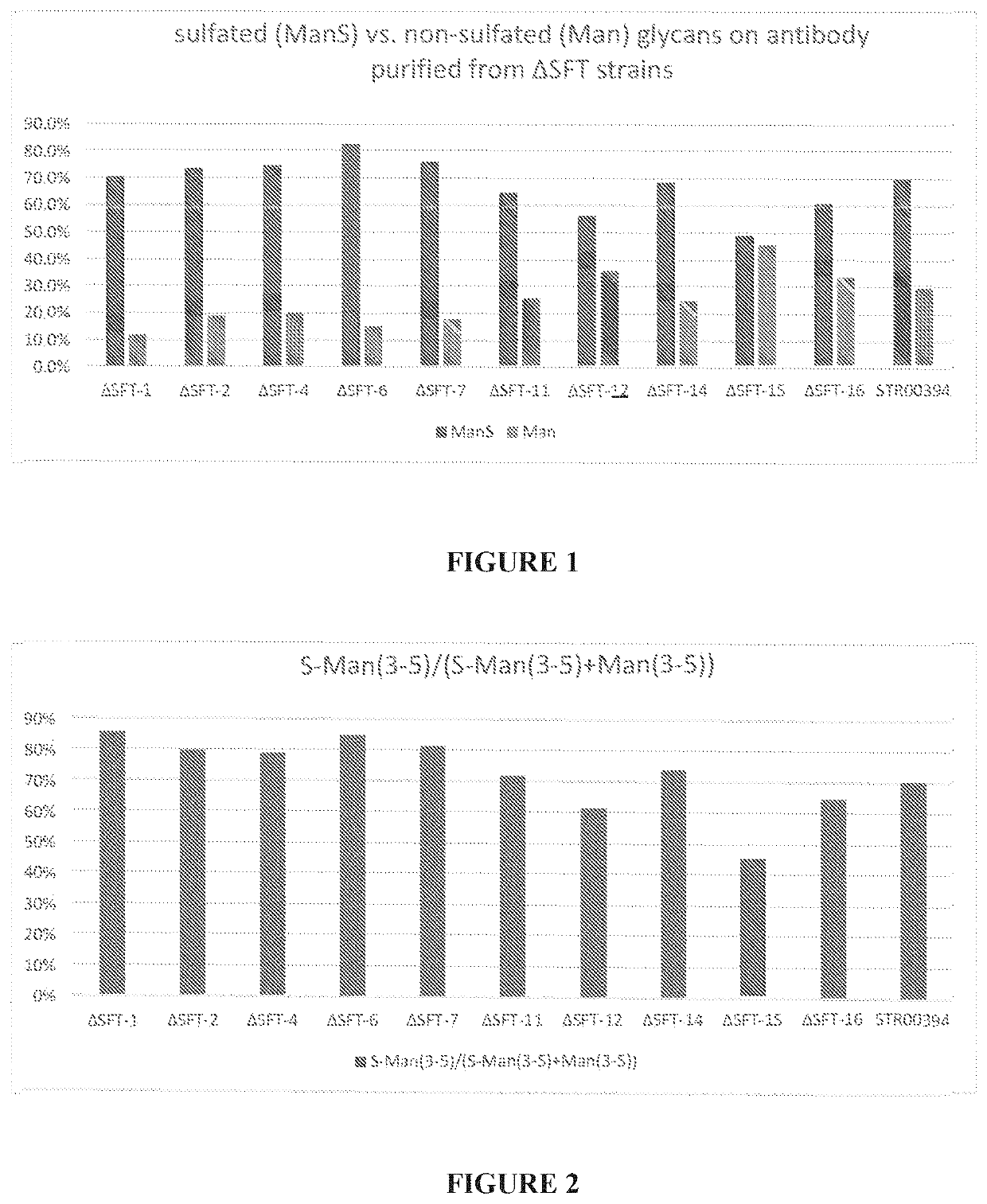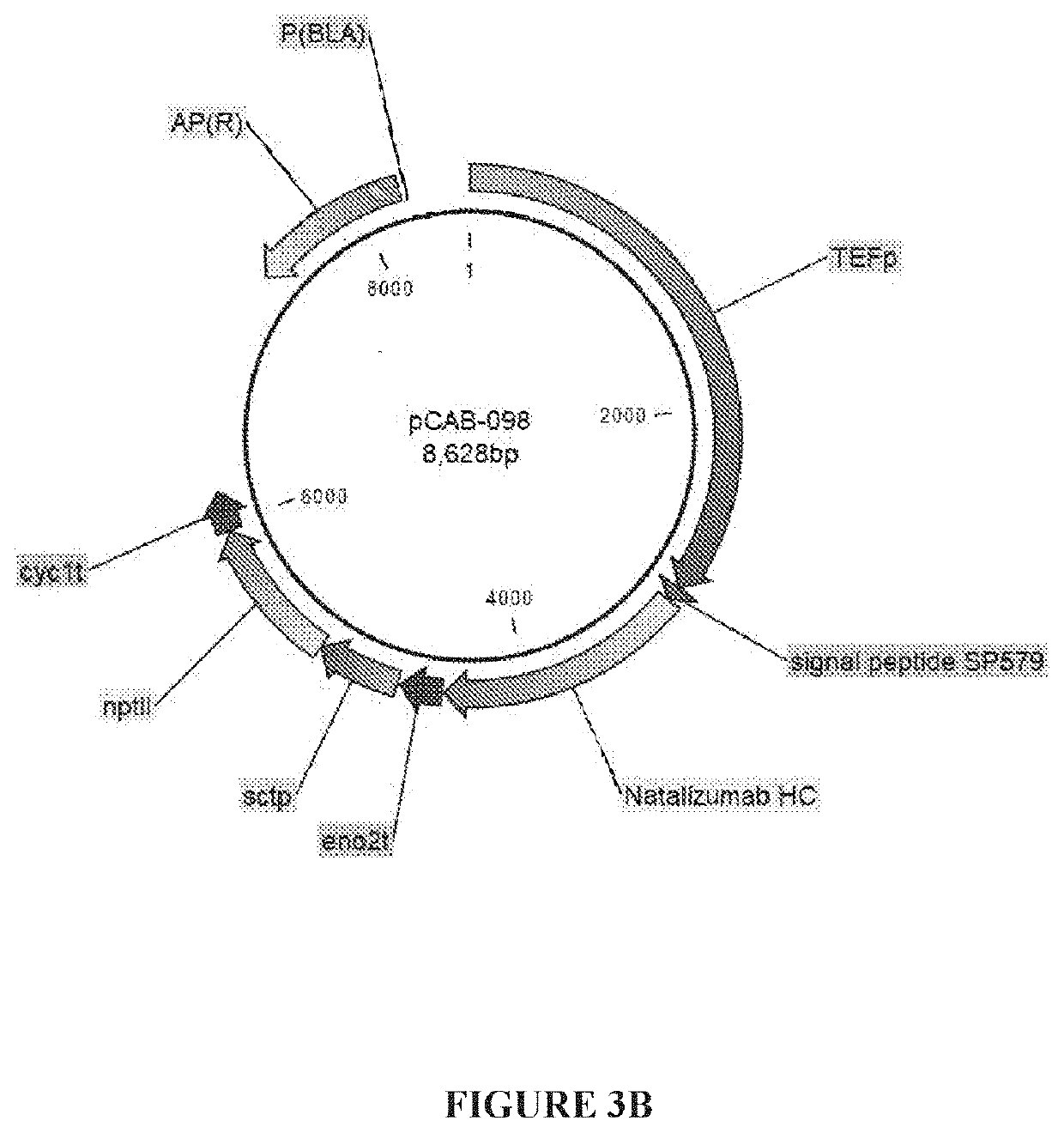Organisms and methods for producing glycomolecules with low sulfation
a glycomolecule and low sulfation technology, applied in the direction of immunoglobulins, peptides, transferases, etc., can solve the problem of slow growth of organisms, achieve low sulfation profile, reduce or eliminate expression or activity, and be safer for use
- Summary
- Abstract
- Description
- Claims
- Application Information
AI Technical Summary
Benefits of technology
Problems solved by technology
Method used
Image
Examples
example 1
Synthesis of Constructs for Producing Heterologous Glycomolecule
[0060]Natalizumab is a humanized IgG4k monoclonal antibody useful in the treatment of multiple sclerosis and Crohn's disease. Natalizumab expression constructs pCAB097 & 098 (FIGS. 3a and 3b) were synthesized as follows. Constructs pCAB097 is an expression cassette with the TEF promoter (SEQ ID NO: 1) driving expression of the natalizumab light chain (SEQ ID NO: 3) where secretion is mediated by signal peptide #579 (SEQ ID NO: 2). This cassette carries the hph marker for selection.
[0061]Constructs pCAB098 is an expression cassette with the TEF promoter driving expression of the natalizumab heavy chain (SEQ ID NO: 4) where secretion is mediated by signal peptide #579 (SEQ ID NO: 2). This cassette carries the nptII marker for selection.
TABLE 1Description of natalizumab expression constructs.ConstructPromoterSignal peptideGeneMarkerpCAB097TEFSP579 (SEQ ID NO: 2)natalizumabhphlight chainpCAB098TEFSP579 (SEQ ID NO: 2)nataliz...
example 2
Construction of Natalizumab-Producing Strain #6602
[0070]Strains expressing natalizumab were produced by co-transforming the Aurantiochytrium sp. base strain #6267 with pCAB097 and 098 described above that had been linearized by BsaI digestion. Five transformants (clones #3, 14, 15, 20 & 31) were resistant to both hygromycin B and paromomycin and were screened by ELSA for production of antibody. Each clone was cultured overnight in 3 mL FM002 (17 g / L Instant Ocean®, 10 g / L yeast extract, 10 g / L peptone, 20 g / L dextrose) in a 24-well plate. They were then diluted 1000× into fresh FM002 (2.5 mL) and incubated for about 24 hours. The cells were pelleted by centrifugation (2000 g×5 min) and the supernatants assayed for the presence of antibody by HC-capture / LC-detect sandwich ELISA. All five clones produced detectable antibody. These clones were again cultured as described and accurate titers were obtained using a commercially available human IgG subclass profile kit. These titers are sh...
example 3
Construction of Natalizumab Producing Strain Carrying Cas9, #6920
[0073]Cas9 was introduced into the natalizumab base strain by transforming this strain with the cassette pAM-001 linearized by digestion by AhdI. Zeocin™ resistant colonies were examined for presence of the cassette by GFP fluorescence on a Typhoon™ FLA 9000 laser scanner. These natalizumab+Cas9 transformants producing GFP were screened for the presence of the Cas9 expression cassette by amplification of an appropriately sized product by PCR using primers oSGT-JU-1360 and PF640 (SEQ ID Nos: 7 and 41). These primers would amplify the Cas9 expression cassette from the 3′ end of the hsp60 promoter to the 5′ end of the sv40 terminator. Ten positive clones were examined for production of natalizumab by ELISA. Clones were cultured overnight in 3 mL FM002 (17 g / L Instant Ocean®, 10 g / L yeast extract, 10 g / L peptone, 20 g / L dextrose) in a 24-well plate. 10 μL of this culture was used to inoculate fresh FM002 (3 mL) and incubat...
PUM
| Property | Measurement | Unit |
|---|---|---|
| composition | aaaaa | aaaaa |
| structure | aaaaa | aaaaa |
| stability | aaaaa | aaaaa |
Abstract
Description
Claims
Application Information
 Login to View More
Login to View More - Generate Ideas
- Intellectual Property
- Life Sciences
- Materials
- Tech Scout
- Unparalleled Data Quality
- Higher Quality Content
- 60% Fewer Hallucinations
Browse by: Latest US Patents, China's latest patents, Technical Efficacy Thesaurus, Application Domain, Technology Topic, Popular Technical Reports.
© 2025 PatSnap. All rights reserved.Legal|Privacy policy|Modern Slavery Act Transparency Statement|Sitemap|About US| Contact US: help@patsnap.com



